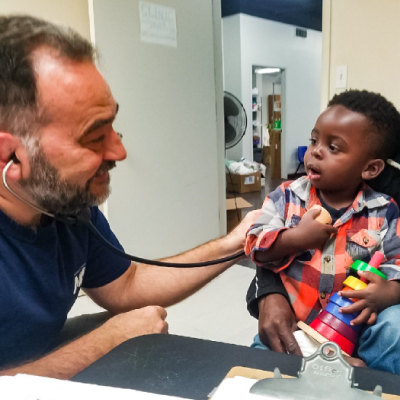- Who We Are
- Clinician Employment
- Publications
- Witness to Witness (W2W)
- Kugel & Zuroweste Health Justice Award
- Your Voice Matters: Photovoice Project
Tue, 09/01/2015 | by Claire Hutkins Seda

 [Editor’s note: This week, drug store chain CVS made headlines for its new partnership with three major telehealth service corporations, giving another boost to the movement for online doctor’s consultations. Telehealth’s growth has been challenged in legal disputes, in which telehealth is derided as potentially providing substandard care based on limited objective diagnostic data. In the following excerpt from our Spring issue of Streamline, MCN’s quarterly clinical publication, we explore telehealth in the context of rural underserved patients who may have challenges in receiving health care otherwise. Visit our Streamline page to download past issues or to sign up to receive the publication in print.]
[Editor’s note: This week, drug store chain CVS made headlines for its new partnership with three major telehealth service corporations, giving another boost to the movement for online doctor’s consultations. Telehealth’s growth has been challenged in legal disputes, in which telehealth is derided as potentially providing substandard care based on limited objective diagnostic data. In the following excerpt from our Spring issue of Streamline, MCN’s quarterly clinical publication, we explore telehealth in the context of rural underserved patients who may have challenges in receiving health care otherwise. Visit our Streamline page to download past issues or to sign up to receive the publication in print.]
On the remote island of Matinicus off the coast of Maine, there is no health clinic, which is to be expected: The tiny lobster and fishing community is home to just 50 residents, although that population figure grows when summer visitors arrive. And yet all residents can access both primary care and specialty services when a boat called the Sunbeam arrives twice a month, with a nurse on board, and an exam room on the boat with a cart of equipment to facilitate communication with primary care providers at a health center off the island. This telehealth program, unique in its inclusion of primary care into the suite of offered services, is operated in part by a Federally Qualified Health Center (FQHC) called Islands Community Medical Center, located on Vinalhaven, a much larger island about a dozen miles north of Matinicus.
With the aid of a 32-inch television screen, a Polycom camera that hooks up to the TV, a microphone, and a telephonic stethoscope, the nurse on the boat can connect to a primary care provider on Vinalhaven, check a patient’s vital signs, report information to the provider, and answer any questions of the provider.
“It’s been great to have telemedicine,” says Dinah Moyer, the Executive Director of Islands Community. Before the Sunbeam began its services, island residents could spend upwards of seven and a half hours a day in travel, to reach a specialist on the main land. Now, patients can board the boat for basic services as well as specialty care. She admits that the commitment is high for a small population. “We probably see between 30 and 50 visits a year, including behavioral health,” she estimated. But it works, she says, in large part because of a start-up grant that covered the cost of the equipment, and the dedication of the Sunbeam’s operator, Maine Seacoast Mission, a nonprofit that runs non-denominational services for island communities. “The Sunbeam goes out to the islands and they have coffee; they have a supper. They are going anyway even if they don’t have medical visits,” Moyer said; the collaboration fits the missions of both parties, and the remote, if small, population benefits greatly.
Primary care services through telehealth is a good use of the technology, says Steve North, the founder and medical director of the nonprofit Center for Rural Health Innovation (CRHI). “When most people think of telehealth, [they think] it’s a way to bring specialty care into primary care offices. That’s a great application; however, it doesn’t do a whole lot to offset needs for preventative care and ongoing care,” North said, particularly for populations that cannot get to those primary care offices in the first place. CRHI operates a school-based telemedicine program in 22 rural schools, in three counties in the Appalachian Mountains of North Carolina. If a child gets sick at school, the school nurse may opt to have the child see a practitioner through CRHI’s telehealth set-up: two-way secure video conferencing, a telephonic stethoscope, an otoscope fitted with a tiny camera, and a general exam cam that can do close-ups on a rash.
 While trained professionals are preferred, non-trained staff can still at the minimum facilitate an appointment. When a nurse is unavailable, another staff person – the school’s secretary, for example – may step in. “One of the great things about telehealth is the ability to use a wide variety of folks to present that patient,” North said. Nonetheless, non-trained staff would not be as useful in, for example, checking lymph nodes. “Your diagnostic abilities can be somewhat limited, based upon the fact that, as our executive director says, you can’t palpate, and you can’t smell. Beyond that, I can do anything that I can do in my office.”
While trained professionals are preferred, non-trained staff can still at the minimum facilitate an appointment. When a nurse is unavailable, another staff person – the school’s secretary, for example – may step in. “One of the great things about telehealth is the ability to use a wide variety of folks to present that patient,” North said. Nonetheless, non-trained staff would not be as useful in, for example, checking lymph nodes. “Your diagnostic abilities can be somewhat limited, based upon the fact that, as our executive director says, you can’t palpate, and you can’t smell. Beyond that, I can do anything that I can do in my office.”
The software installed in the cart provides extra features. “Any of the images we see, we can... freeze and pull into the EHR,” says North. The practitioner can also remotely control the general exam cam’s view – to remove glare, or increase the light. Total cost? Around $20,000 for the equipment, software, and installation – although North notes that there are less expensive carts, and the overall cost of telehealth is declining as its popularity increases. Moyer’s equipment, she noted, was much more expensive when they purchased it in 2004.
Like Islands Community, CRHI started up with grants. It has received local, state, and federal funds to offset equipment costs and pay for practitioners’ salaries. For those with insurance, CRHI bills for its visits through multiple insurers.
Equipment costs do not end after they’re initially purchased. Back on Matinicus, the nurse on the Sunbeam doesn’t often use the telephonic stethoscope, Moyer said, because it isn’t fully functioning. Moyer noted that some of the telehealth equipment is over a decade old. Funds will need to be raised again at some point, to upgrade.
Utilization of services is another issue. North admits that his team has to work constantly at increasing utilization of the services. “We’re delivering care in a new site, for all of these communities,” North said, noting the school-based medicine movement is only about 30 years old. Adding a new way of delivering that care – through telehealth – makes it even more difficult to break into new communities successfully.
Still, North believes there’s a potential for similar set-ups to provide primary care to remote, underserved populations, like migratory agricultural workers in rural camps. “You’d be able to connect to a culturally-competent provider,” he noted as one benefit, adding that telehealth would be effective for “keeping the uninsured and undocumented folks in their community for care, as opposed to needing to travel 50 miles for cellulitis, or an asthma exacerbation -- things that could easily be treated via a telehealth setup.”
Connectivity is less and less an issue, said North. “It’s not unreasonable to run a telehealth unit through a 4G LTE signal,” he said, meaning that, in most places where a smartphone gets service, a telehealth cart can help patients see a practitioner. Conversely, practitioners only need that same level of service connection. North recalled receiving a call from one of CRHI’s schools informing him of a sick patient while driving to rural Kentucky. He pulled off the freeway and pulled out his laptop. With the laptop visuals and phone conversation, he said, “I saw the patient, prescribed medication, talked to the family, and did everything that I could, remotely.”
North also sees many new applications of telehealth for the primary care world in the future. Recently, CRHI received a small grant to bring a telehealth cart to a small community, where patients can contact their individual primary care providers, who only need to download the provided software to be able to see their patients remotely. If the provider is not available, CRHI’s Nurse Practitioner will see the patient and update the provider after the visit.
“There’s real potential there, in… community-driven telehealth programs,” North believes. As telehealth expands beyond specialty care, Islands Community and CRHI serve as early models in how to bring needed primary care services to populations who may otherwise be underserved.
Telehealth reimbursements
Medicare covers limited telehealth services provided by a community health center like Islands Community Medical Center to an eligible patient through a Medicare Part B code specific for telemedicine -- code 0780. A facility fee code (Q1014) is also used, which indicates that telemedicine equipment was used. No deductible is necessary for this Medicare service. Additional billing information, including a list of covered services and corresponding codes is available on the Centers for Medicare and Medicaid Services (CMS) website.1
Medicare will only reimburse services provided to a patient located in a county outside of a Metropolitan Statistical Area (MSA) or in a rural Health Professional Shortage Area. The Health and Resources Services Administration (HRSA) website provides a tool to determine eligibility of an originating site -- where the clinician providing telehealth to remote patients is located.2 Authorized originating sites include practitioner offices, hospitals, Critical Access Hospitals (CAHs), community mental health centers, skilled nursing facilities, rural health clinics, federally qualified health centers (FQHCs) and hospital-based or CAH-based renal dialysis centers.1
Telehealth services may be used for follow-up appointments that, if provided through other means like a phone call follow-up, would not be reimbursable. At Islands Community Medical Center, their contractual dentists are on the mainland, several hours away. Currently, the dentists are called several times a week to review digital X-rays sent remotely. They then coordinate care telephonically with the dental assistant or hygienist at Islands Community’s main facilities on Vinalhaven. Use of telemedicine would allow scheduled review as well as a reimbursement channel. Many other similar uses of telehealth may be possible if equipment is available on the patient’s end.
RESOURCES
1 Centers for Medicare and Medicaid Services. Medicare Learning Center Telehealth Services. http://www.cms.gov/Outreach-and-Education/Medicare-Learning-Network-MLN/MLNProducts/downloads/TelehealthSrvcsfctsht.pdf. Accessed February 26, 2015.
2 Health and Human Resources Administration. Medicare Telehealth Payment Eligibility Analyzer. http://datawarehouse.hrsa.gov/telehealthAdvisor/telehealthEligibility.aspx. Accessed February 26, 2015.
3 Centers for Medicare and Medicaid Services. Telehealth. http://www.cms.gov/Medicare/Medicare-General-Information/Telehealth/index.html. Accessed February 26, 2015.
These two articles first ran in Streamline, Migrant Clinicians Network’s quarterly clinical publication. Visit our Streamline page for more on our publication.
Like what you see? Amplify our collective voice with a contribution.
Return to the main blog page or sign up for blog updates here.







